Are you trying to figure out the difference between pho vs ramen or wondering which is healthier? Pho, pronounced as “Fuh,” has been in existence for hundreds of years and is a classic Vietnamese dish. Ramen, on the other hand, is Japanese in origin and contains an entirely different set of ingredients. This article will discuss these two popular, yet very different, forms of noodle soups.
Table of Contents
Pho vs. Ramen: At a glance
| Differences in: | Pho Noodle Soup | Ramen Noodle Soup |
|---|---|---|
| Noodles | flat white noodles (naturally gluten-free) | curly yellow egg noodles (contains gluten) |
| Broth | beef based, cooked with spices of ginger, star anise, fennel, coriander, cloves, and sometimes cinnamon | pork based, seasoned with miso, salt and soy sauce. |
| Meats | mostly beef plus some beef organs such as oxtail, tripe (stomach lining), and tendon | egg, pork, fish cake |
| Flavor and spices | mild and herby, since it is meant to be seasoned with hoisin or sriracha (on Amazon). | stronger tasting, anchovy like, saltier and much richer |
| Preparation | basically a bone broth – lots of beef bones simmered for many hours, hard and takes longer to prepare at home | many instant varieties available, quicker to cook |
| Nutritional Value | less carbs, less fats, more calories | more fats, more fats, less calories |
| Variations | mostly beef broth but sometimes whole chicken or chicken bones is used | beef slices instead of pork, can also be served dry instead of in a broth |
| Vietnamese vs Japanese | Vietnamese | Japanese |
| Toppings and Condiments | scallions, sliced onions, beansprouts, mint or basil, sometimes jalapenos | green onion, nori (seaweed), pickled radish, fish cakes, soft-boiled eggs, chile peppers, carrots, corn, and bean sprouts. |
What is pho?
Pho is a Vietnamese noodle dish that originated in the early 1900s. Pho was originally created to feed the poor Chinese immigrants and Vietnamese farmers. Pho is a Vietnamese beef and rice noodle soup dish. It spread across the country and became a popular culinary trend. Pho didn’t come to America until the 1980s, but when it did, it became a big hit.
Pho is a Vietnamese dish made from boiled beef and rice noodles. Pho is said to have originated from Hanoi and French influences are seen in the dish’s ingredients and preparation. Pho has become popular around the world and is a staple in many Vietnamese diets.
Pho is a Vietnamese noodle soup consisting of beef or chicken bones and spices. Pho is often made with beef bones and aromatics, such as onions, garlic, and salt. Today, there are many variations of pho on the market, including seafood versions.
Pho is a Vietnamese noodle soup that can be made with a variety of broths and garnishes. Pho varies depending on the region it is from, with some broths being slightly sweeter than others. Pho is a popular dish and can be found in many restaurants
What is ramen?
Ramen is a type of noodle soup dish that originated in China. The dish typically consists of a pork-based broth, noodles, and a variety of toppings such as moyashi (bean sprouts), kamaboko (steamed fish cake), and corn.
There are many different types of ramen, with different broth and flavor profiles. The most popular type is tonkotsu ramen, which contains pork bones that have dissolved into a thick, cloudy, white and creamy soup. Ramen is a budget-friendly and universally available noodle soup dish.
How is Pho different from Ramen?
Pho is a type of Vietnamese noodle soup that’s typically made with bones and meat simmered for 4+ hours. Ramen, on the other hand, is a Japanese noodle soup that’s typically made with pork or chicken and is miso and soy based.
Is ramen or pho better?
Pho is a bone broth – all the benefits of bone broth is packed in this bowl of noodle soup. It is also served with rice noodles which is naturally gluten-free. Ramen, on the other hand, is made with soy and miso based broth and served with gluten-containing noodles. For these reasons, Pho is the better choice.
Related article: How is Healthy Pho Better Than Any Other Bowl of Noodle Soup?
Pho vs Ramen: The Noodles
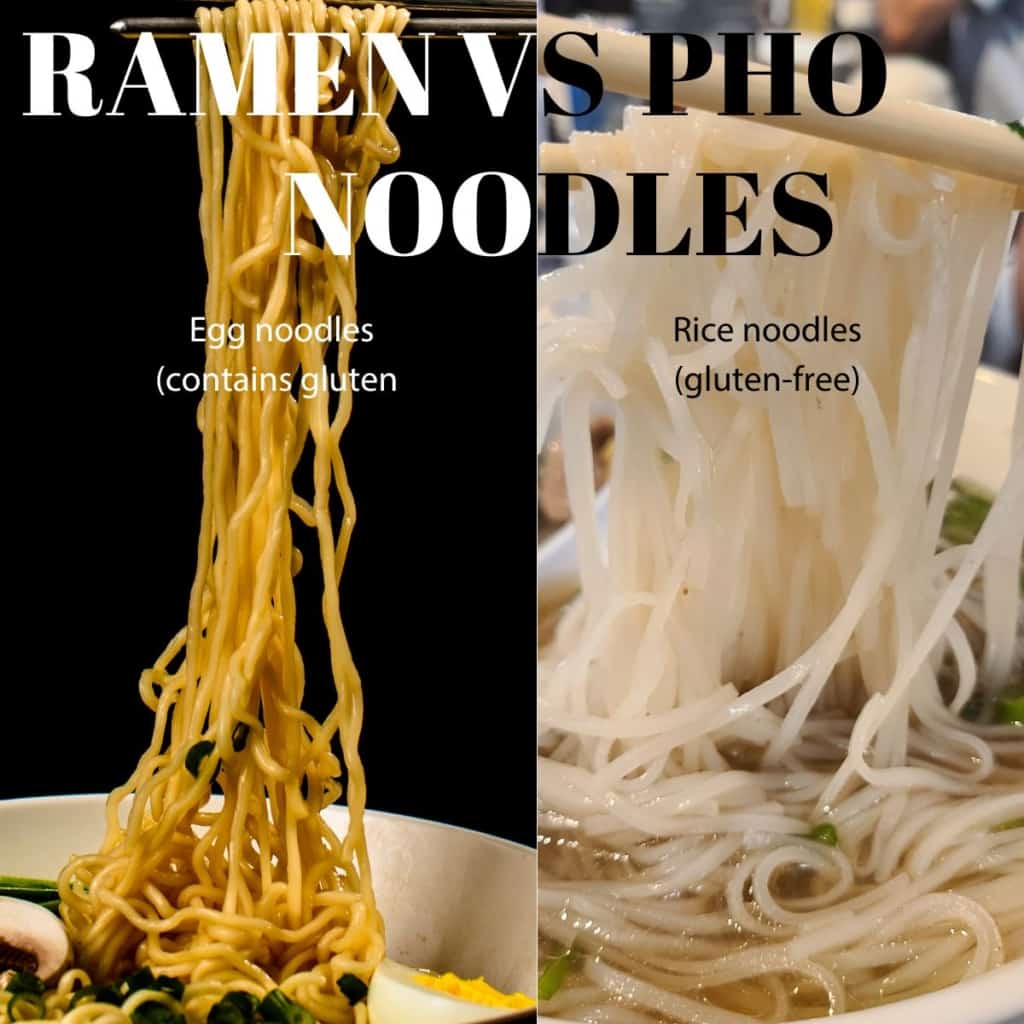
- Ramen noodles have a special ingredient: kansui. Kansui is a form of alkaline water originally from Mongolia , which is said to give ramen noodles that firm texture.
- Pho noodles are made of rice, which is the foundation of any good bowl of the Vietnamese comfort food. This makes Pho noodles naturally gluten-free.
- Ramen noodles boast thicker wheat or egg noodles with a firm and springy texture and contains gluten.
Pho vs Ramen: The Broth
- Ramen broth is made from chicken or pork bone stock, which is then seasoned with different spices. Ramen is richer in broth, with additional flavors including soy and miso.
- Pho is a Vietnamese noodle soup that is usually made with beef, tendon and tripe. The star anise, cinnamon, and clove give the broth its signature flavor. Pho is also considered a bone broth based on its preparation method. It has lots of rich cartilage and collagen bones and meats that has been simmered for 4 hours or more and is packed with herbs and spices.
Pho vs Ramen: The Meats

Pho is typically served with a combination of thinly sliced meat: eye round steak, brisket, tendon, tripe, or flank. It is typically garnished with scallions and yellow onions, served with a side of optional beansprouts, lime wedge, and mint.

Hoisin Sauce (on Amazon) and Sriracha (on Amazon) –
Optional sauces for your Pho broth
Side Vegetables for Pho
beansprouts, basil, and lime wedges
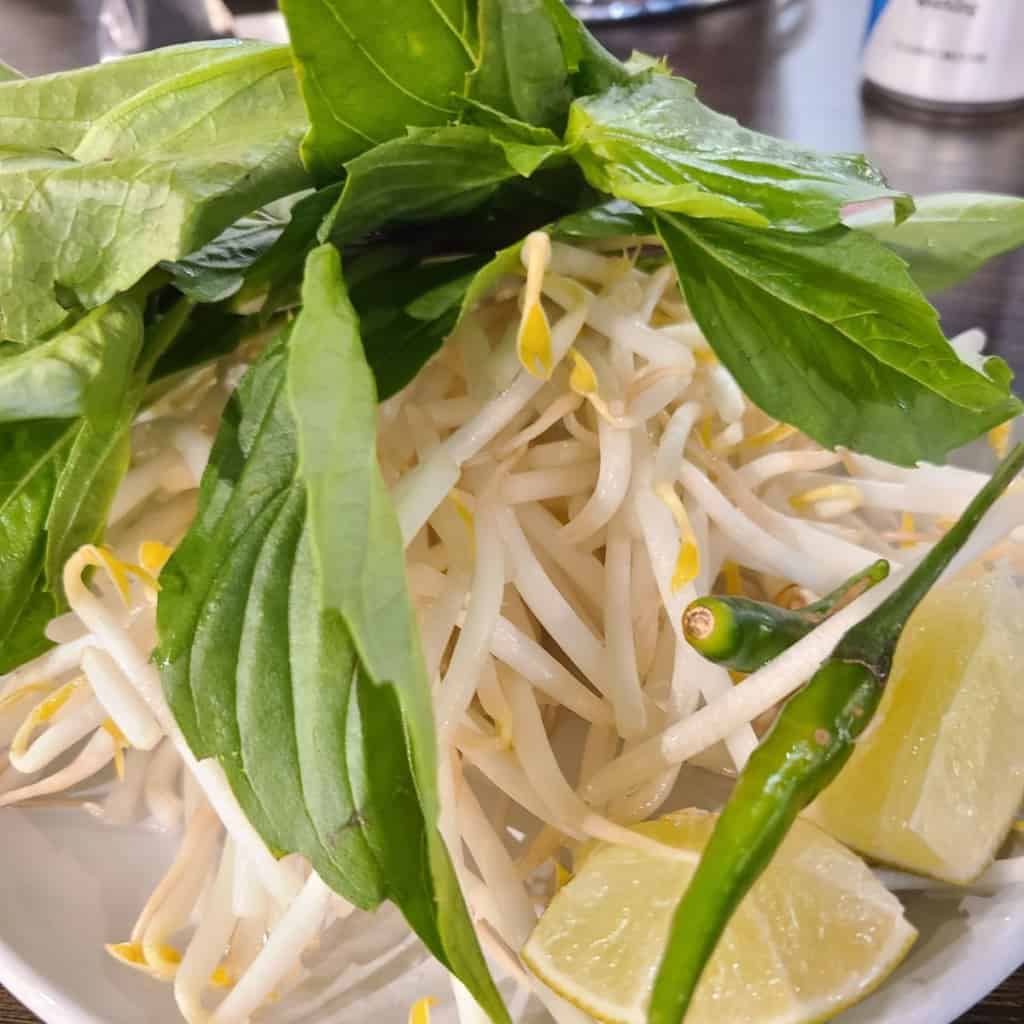
Hoisin sauce (on Amazon) and Sriracha (on Amazon) is then used to add more flavor – it is up to you to add them after the bowl is served – it is not made with them.
For a more in-depth discussion on Pho meats, see our Pho Meats Guide

Ramen is typically served with a soft boiled egg, pork slices, corn, seaweed, sometimes bamboo shoots, and scallions or nori sheet as garnishing. Unlike Pho, ramen is sometimes also served dry, but it can be served in a broth as well.
Related Article: Pho Meat Guide – The Ultimate Guide To Ordering Pho Meats
Pho vs Ramen: Flavor and Spices
Ramen and pho are two delicious soup dishes that differ slightly in flavor. Ramen is typically stronger tasting, with a more pronounced anchovy and pork flavor. This would make sense once you understand that ramen is prepared with ingredients with strong taste profiles such as anchovies, dried bonito, pork, soy sauce, and miso.
Pho, on the other hand is more mild tasting, and more aromatic in its flavors, since it derive most of its flavors from spices. Pho spices consist of: ginger, onion, coriander seeds, cloves, and star anise.
Pho vs Ramen: Preparation
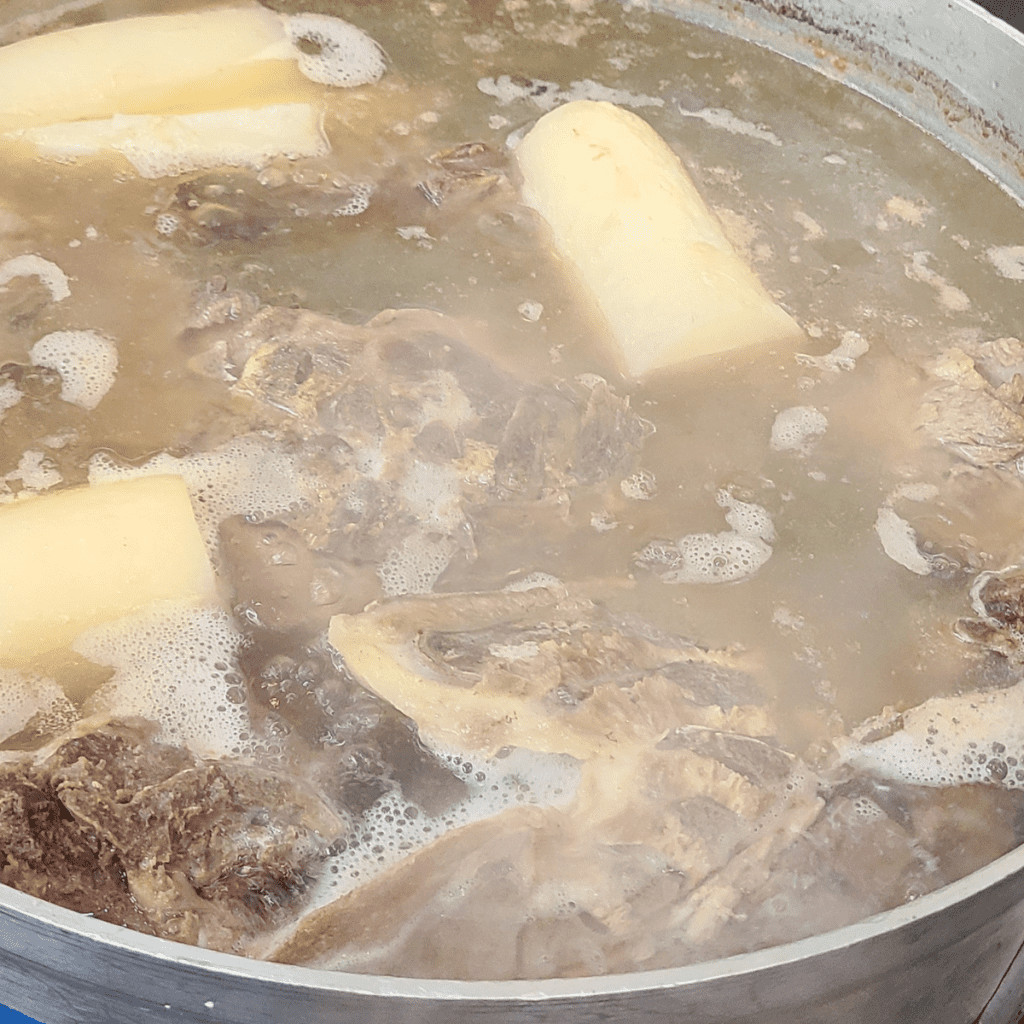
- Pho involves a lot more preparation than ramen, including the need for meats and vegetables.
- In pho, you’ll often find thinly sliced meat — everything from chicken to beef to organ meat like tripe; herbs like cilantro and basil; jalapeño; lime; and a handful of bean sprouts served with a side of hoisin and sriracha sauce that you can mix in to adjust the heat or sweetness to your liking. These meats and ingredients might make it slightly more difficult to prepare pho in an average American kitchen.
- Ramen, on the other hand, is available in different forms of instant ramen noodles, and it is easy to add a soft boiled egg, a nori sheet, and some cooked corn to your soup at home.
Pho vs Ramen: Nutritional value
- Pho is lower in fat than ramen, and has a lot of the ingredients freshly picked.
- The cuts of meat used in ramen are usually fattier and thicker than in pho.
- An average bowl of ramen tops out at 15g of fat, while a bowl of pho typically has 5g or less.
- When talking about calories, a medium bowl of ramen contains 350 calories, while a medium bowl of pho contains 550 calories..
- Ramen has more carbs and less protein while pho has more protein and fewer carbs.
- Pho has more sodium than ramen.
- The winner of this nutritional showdown is pho!
Pho vs Ramen: Variations
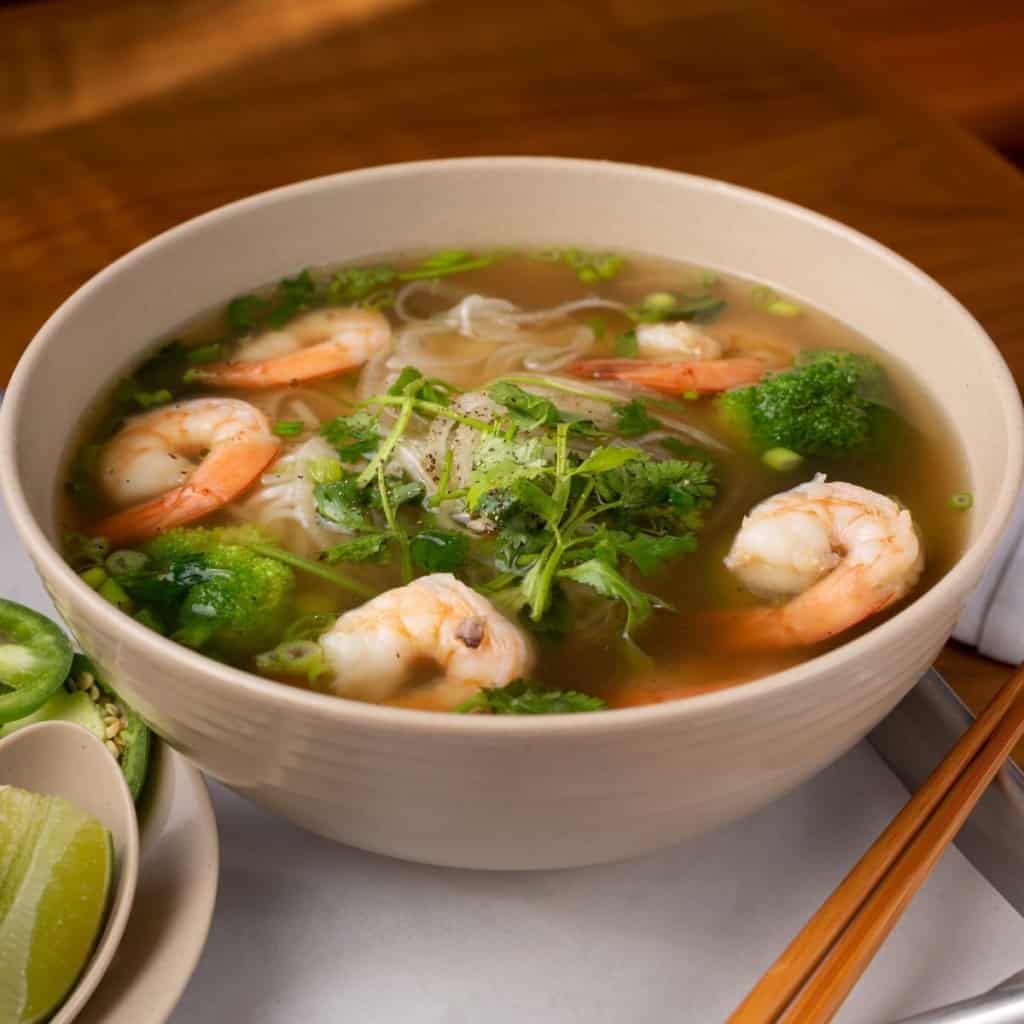
Pho can be served with the meats you typically find at restaurants that are lightly harder to get at home – thinly sliced eye round steak, tendon, tripe, and thinly sliced brisket. However you can happily substitute chicken, vegetarian, or seafood! Some restaurants already offer these as options.
Ramen noodle soup can be served dry or in a broth – this makes it more fun to eat, depending on the mood you’re in! You can serve it with roasted slices of pork or chicken, a soft boiled egg, or even a fried one!
Pho vs Ramen: Vietnamese vs Japanese Origins
Pho was made in Vietnam and has a slight French influence because northern Vietnam was once under colonization by the French. Ramen originated in Japan, when Chinese immigrants brought Chinese wheat noodles to the island.
Pho is a Vietnamese noodle dish consisting of broth, noodles, meat, and herbs. It originated in Vietnam in the early 1900s, and many believe it reflects the country’s various cultures at that time. The French colonists made beef easy to get, while the Chinese immigrants brought noodles from their home country.
Pho vs Ramen: Toppings and Condiments
When it comes to toppings for pho and ramen, there are lots of options to choose from! For pho, traditional toppings include herbs like Thai basil, mint and cilantro; bean sprouts; sliced fresh Jalapeño or Fresno chiles; fish sauce (on Amazon); and hot chili oil. In the United States, toppings like lime wedges and Sriracha are also commonly used.
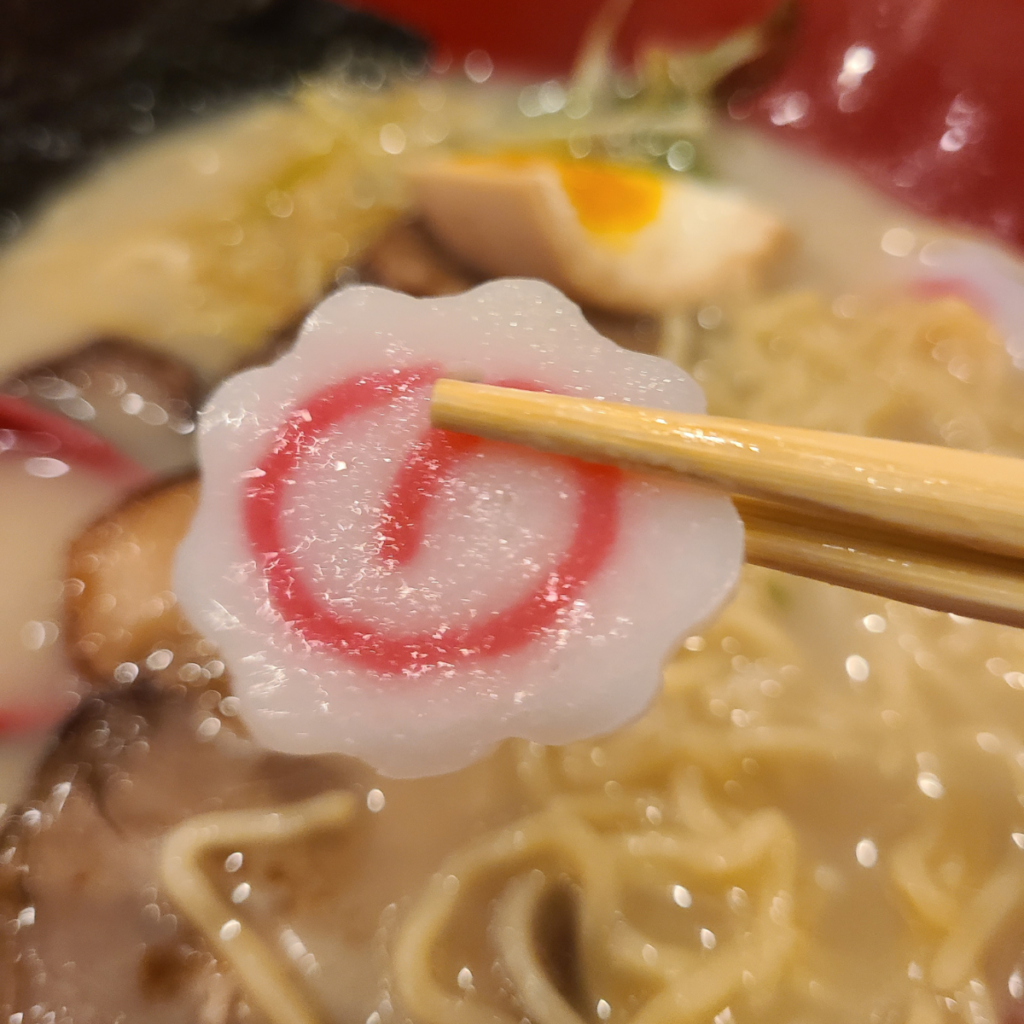
For ramen, toppings may include Chashu, sometimes also known as “char-siu” and various other spellings. It is basically barbecued pork. Other toppings may include green onion, nori (seaweed), pickled radish, fish cakes (pictured), soft-boiled eggs, chile peppers, carrots, corn, and bean sprouts.
Pho vs. Ramen: Noodle Comparisons with Soba and Udon
Exploring Asian noodles leads to some intriguing contrasts, especially when comparing pho and ramen with other popular types like soba and udon. Each noodle brings its own flavor and texture to the table.
Compared to Soba:
- Pho: Pho noodles are thin, rice-based, and offer a delicate chewiness, which contrasts with soba’s grainy, buckwheat composition. Pho is typically served in a clear, aromatic broth that highlights its light texture, unlike soba noodles which can be enjoyed either cold with dipping sauces or in a hot broth.
- Ramen: Ramen noodles are also wheat-based but are much thicker and chewier than soba noodles. Ramen’s rich, often meaty broths pair with its elastic texture, differing from soba’s earthy, subtle taste and versatility in both cold and hot preparations.
Compared to Udon:
- Pho: The fine, slippery texture of pho noodles is much lighter compared to udon’s thick, chewy wheat noodles. Udon’s dense structure is often served in hearty, savory broths, providing a stark contrast to pho’s fragrant and spiced, yet light broth.
- Ramen: Like udon noodles, ramen noodles are made from wheat but are generally slimmer and less dense, offering a different chewiness. While udon noodles thrive in simple, mildly flavored broths, ramen typically features a diverse array of complex and deeply flavored broths.
This overview shows how pho and ramen offer distinctly different dining experiences from soba and udon, emphasizing the unique culinary niche each occupies within Asian cuisine.
Pho vs Ramen: Conclusion
For health reasons described above, Pho is the clear winner.
The health benefits of bone broth is indisputable and have been gaining popularity over the past few years. It is also naturally gluten-free. However it is difficult to prepare at home.
Pho is also served with lots of beef meat, organs, tendons, and cartilage. If you believe in eating “the whole animal”, you can’t find another dish that has this much variety of the cow.
Ramen, on the other hand, gives you more options to prepare at home. It does contain soy and gluten noodles, therefore we do not prefer it. However, its rich tasting broth is superior to that of Pho’s star anise and cinnamon.
FAQ
Is Pho Japanese?
No, Pho is Vietnamese. It originated in Vietnam in the early 1900s and made its way into American cuisine after the Vietnam war, around the 1980s, when the Vietnamese first started immigrating to the States.
Is Ramen Vietnamese?
No, Ramen is Japanese. Ramen originated in Japan when Chinese immigrants brought Chinese wheat noodles to the island.
Can I eat Pho with Ramen noodles?
Yes and no. It’s like asking the question – Can you eat spaghetti with linguine or penne? Of course you can, but it takes away from the authentic flavors. Pho is also naturally gluten-free, why introduce wheat to it?
Should I have Pho or Ramen when sick?
When you’re feeling under the weather, it’s normal to reach for a bowl of hot soup for comfort. Pho and ramen are two popular Asian noodle soup dishes and offer a warm, soothing, and comforting experience that can help you through cold and rainy days. But you should choose Pho, and here’s why.u003cbru003eu003cbru003ePho is the healthier option. It has a lot of spices such as ginger, cinnamon, cloves, coriander, and star anise that are antibacterial and antifungal in nature. It has zero gluten and no allergen-inducing ingredients. u003cbru003eu003cbru003eRamen, on the other hand, has gluten noodles and also have miso and soy – two ingredients that are known to cause allergic reactions. When you’re sick and your immune system is busy fighting foreign invaders, it might not be the best idea to force it to fight allergens, too.u003cbru003eu003cbru003eIf your taste buds aren’t really there and you’re looking for a bowl of good tasting soup you might reach for ramen noodles. If you’re looking to get better faster, Pho might be the better choice.
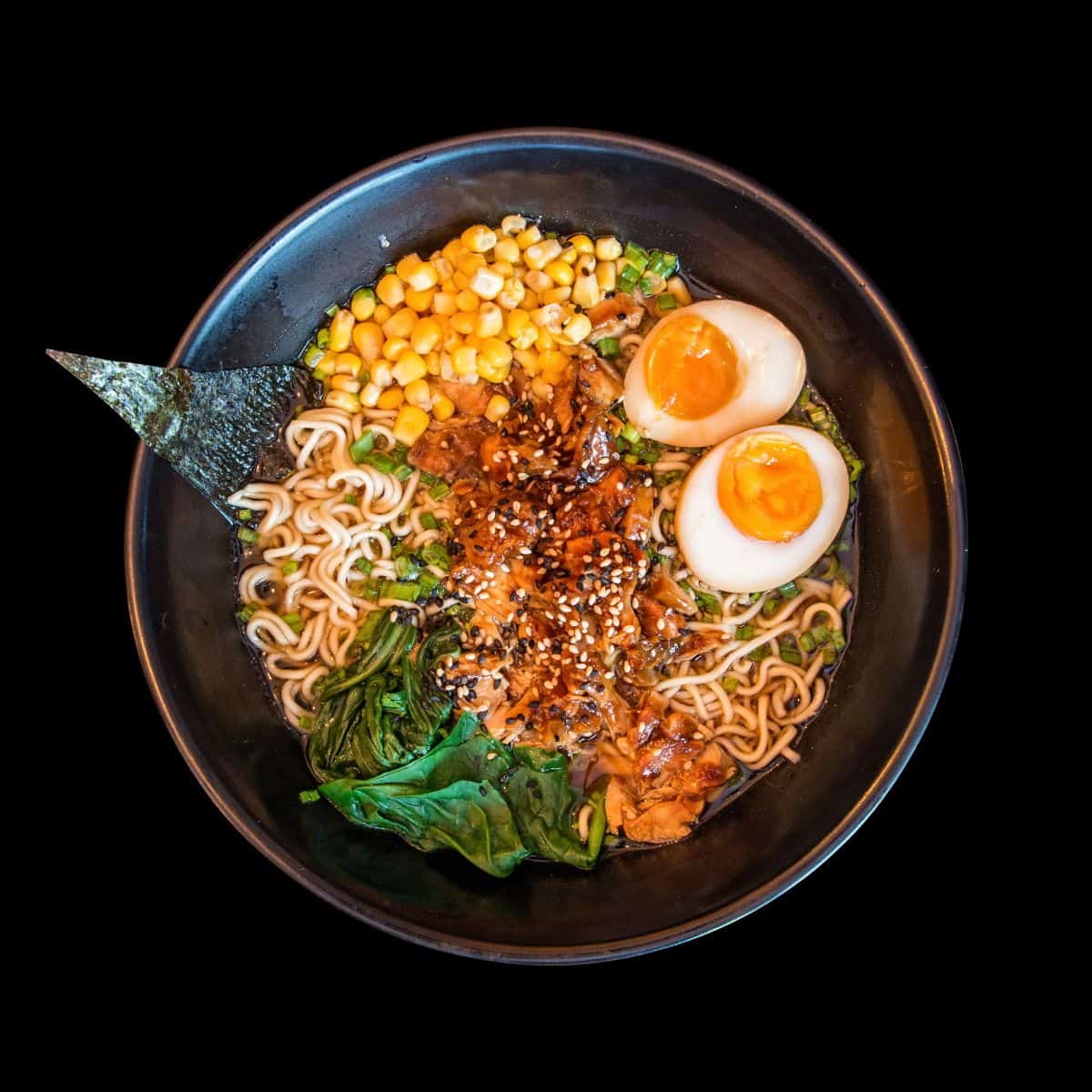
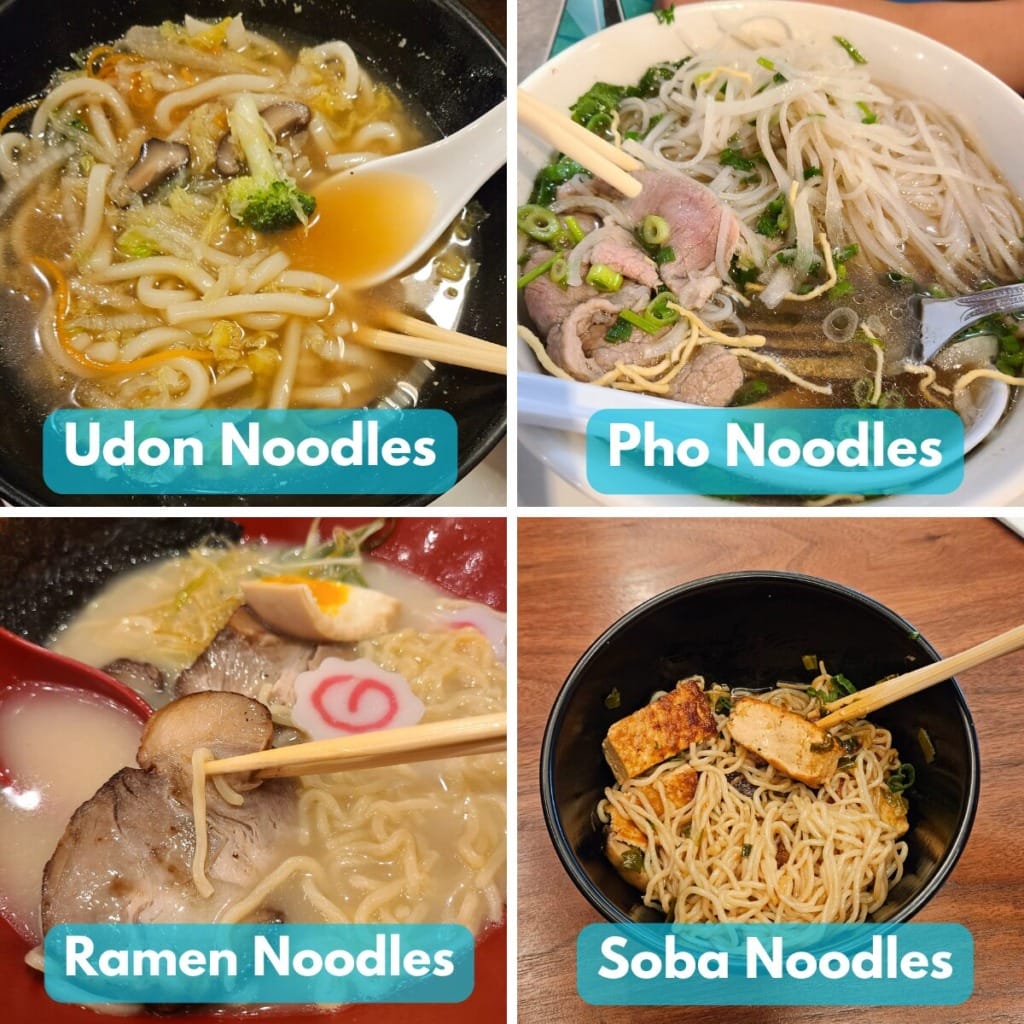

Thanks!
Very very biased. Go read other sources as well. Here you just have input from the pho side.
There is no way pho has more sodium than ramen imo
I agree bone broth does wonders when a person feels under the weather! But I also think it depends greatly on the type of sick a person is. Some people are very sensitive to sodium while sick and pho with its high sodium amount can be dehydrating. On the other hand, some people swear by pho as a hang over cure (which means they don’t feel further dehydrated from pho). Regardless, sodium can be harder to control, there is the option of reducing the amount of carbs or increasing the protein in ramen (half noodle, GF noodle substitute, extra meat, or extra egg are some ideas!).